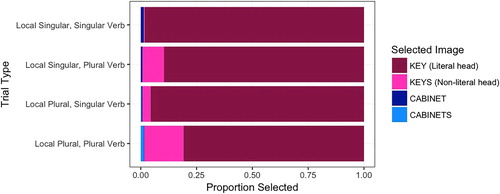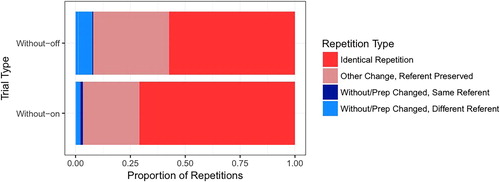Figures & data
Figure 1. Sample image arrays. A: SVA item (The key to the cabinet(s) literally was/were on the table). Top left = literal subject key; bottom left = non-literal subject keys; right pictures = local noun and a non-literal version of it (cabinet/cabinets). B: Without item (Lulu visited the gym without her hat on/off late yesterday night). Top left = Yes-Accessory agent (the literal interpretation of “without + off”); bottom left = No-Accessory agent (the literal interpretation of “without + on” and non-literal interpretation of “without + off”). Right pictures = location of the verb and a semantic competitor for it.
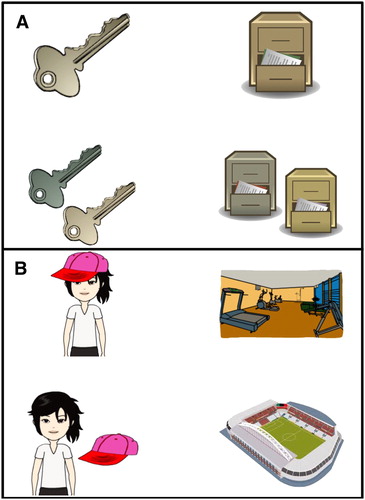
Table 1. Results from logistic mixed-effect regression of subject selection (odds of selecting head noun number competitor versus all other items) for Experiment 1 SVA trials.
Figure 3. Average proportion of fixations to images in Experiment 1 SVA trials receiving a literal sentence interpretation (KEY selected as the subject), zeroed to reflect verb onset. Vertical lines represent onsets of head nouns, local nouns, and verbs; panels represent sentence conditions. Confidence bands are 95% CIs from a non-parametric bootstrap (1000 iterations) sampled over participants with replacement at 10 msec intervals.

Table 2. Results from linear mixed-effect regression of proportion of fixations to head noun number competitor binned at 500 msec time windows for Experiment 1 SVA trials eliciting a literal-head number interpretation.
Table 3. Results from logistic mixed-effect regression of subject selection (odds of selecting non-literal subject versus all other items) for Without trials.
Figure 5. Average proportion of fixations to images in of Experiment 1 Without trials, zeroed to reflect preposition onset. Vertical lines represent onsets of without and prepositions; panels represent sentence conditions crossed with sentence interpretation. The non-literal interpretation of “Without-On” (bottom left panel) was not analysed because of an insufficient number of trials but we present it here for completeness. Confidence bands are 95% CIs from a non-parametric bootstrap (1000 iterations) sampled over participants with replacement at 10 msec intervals.
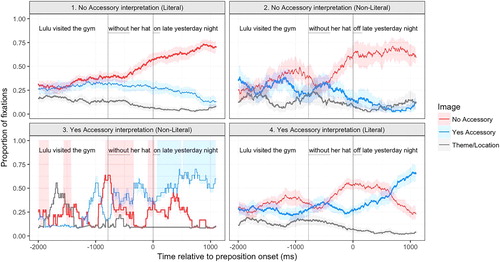
Table 4. Results from linear mixed-effect regression of proportion of fixations to yes-accessory agent binned at 500 msec time windows for Experiment 1 Without trials split by interpretation.
Table 5. Response types by category, Experiment 2 SVA trials.
Figure 6. Sentence repetition for Experiment 2 SVA trials, split by condition and whether the inflection change led to a grammatical or ungrammatical utterance.
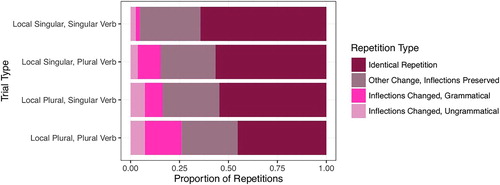
Table 6. Results from logistic mixed-effect regression of responses with number inflection changes, versus identical and other repetitions, for Experiment 2 SVA trials.
Figure 7. Average proportion of fixations to images in the listening phase of SVA trials where all inflections were repeated veridically (identical and other trials), zeroed to reflect verb onset. Vertical lines represent onsets of head nouns, local nouns, and verbs in audio recording; panels represent sentence conditions. Confidence bands are 95% CIs from a non-parametric bootstrap (1000 iterations) sampled over participants with replacement at 10 msec intervals.
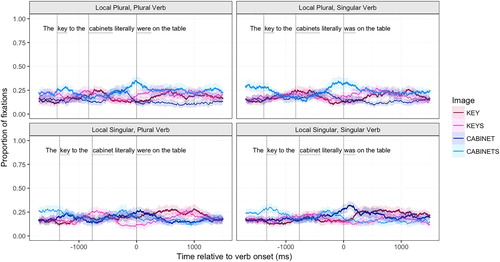
Table 7. Results from linear mixed-effect regression of proportion of fixations to head noun number competitor binned at 500 msec time windows for SVA trials where all inflections were repeated correctly (identical and other trials).
Table 8. Response types by category, Experiment 2 Without trials.
Table 9. Results from logistic mixed-effect regression of repetitions containing without/preposition changes, versus identical and other repetitions, for Experiment 2 Without trials.
Figure 9. Average proportion of fixations to images in the listening phase of Without trials in Experiment 2, zeroed to reflect preposition onset. Vertical lines represent onsets of without and prepositions; panels represent sentence conditions crossed with sentence interpretation. Confidence bands are 95% CIs from a non-parametric bootstrap (1000 iterations) sampled over participants with replacement at 10 msec intervals. Only literal interpretations (identical and other repetitions) were submitted to analyses due to the sparse number of non-literal repetitions (involving changes to without and/or preposition).
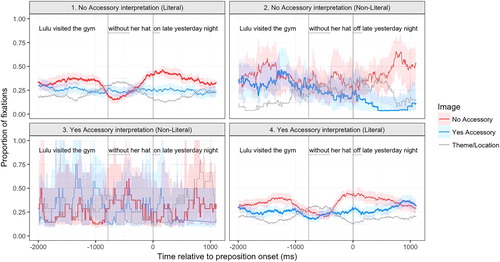
Table 10. Results from linear mixed-effect regression of proportion of fixations to yes-accessory agent binned at 500 msec time windows for literally-interpreted (identical and other repetitions) Experiment 2 Without trials.

